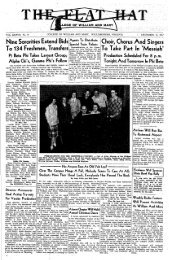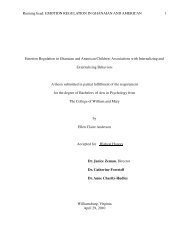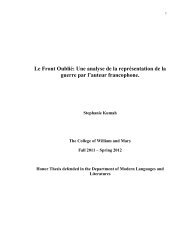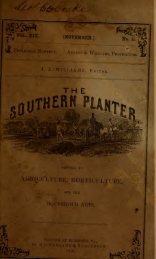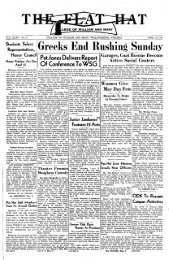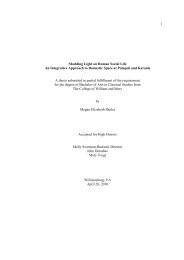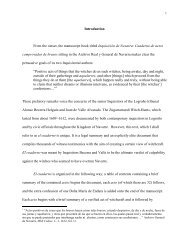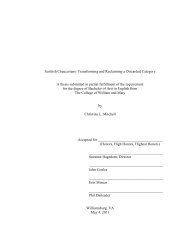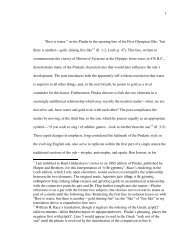Southern planter : devoted to agriculture, horticulture, and the ...
Southern planter : devoted to agriculture, horticulture, and the ...
Southern planter : devoted to agriculture, horticulture, and the ...
Create successful ePaper yourself
Turn your PDF publications into a flip-book with our unique Google optimized e-Paper software.
THE SOUTHERN PLANTER. 433<br />
making <strong>and</strong> savin j^ of hay, a crop <strong>to</strong>o much<br />
neglected <strong>and</strong> indispensable <strong>to</strong> <strong>the</strong> rearing of<br />
fine horses <strong>and</strong> cattle. To save our owm grass<br />
seeds, clovx3r, timothy <strong>and</strong> orchard grass— -<strong>to</strong><br />
make better enclosures, permanent, &c., when<br />
s<strong>to</strong>ne was convenient— <strong>to</strong> give more attention<br />
<strong>to</strong> ditching <strong>and</strong> droning <strong>and</strong> clearing our farms<br />
of <strong>the</strong> various pests, briars, sassafras, garlick,<br />
&G.—<strong>to</strong> provide more comfortable fixtures, shelters,<br />
lots, &c.,for our s<strong>to</strong>ck. The manure from<br />
which, protected from <strong>the</strong> rain, would be doubly<br />
as valuable, <strong>and</strong> half <strong>the</strong> feed consumed<br />
would keep <strong>the</strong>m in better condition.<br />
Our sheep <strong>and</strong> hogs, also, if protected from<br />
<strong>the</strong> snow, s<strong>to</strong>rms, &c., would be much healthi-<br />
er, consume less, <strong>and</strong> <strong>the</strong>ir lots properly littered<br />
would furnish valuable manure, which at present<br />
is. lost.<br />
To pay some attention <strong>to</strong> <strong>the</strong> culture of roots,<br />
which have been <strong>the</strong> basis of <strong>the</strong> wonderful<br />
revolution in English <strong>and</strong> Scotch <strong>agriculture</strong>,<br />
with more time <strong>and</strong> larger resources, <strong>to</strong> improve<br />
<strong>the</strong> quantity <strong>and</strong> quality of our manure<br />
banks, <strong>the</strong> only bank <strong>the</strong> farmer should have<br />
much <strong>to</strong> do Avith, <strong>and</strong> applying it <strong>to</strong> our hungry<br />
hills <strong>and</strong> ridges, thus covering <strong>the</strong>m with<br />
verdure, we might profitably introduce improved<br />
breeds of s<strong>to</strong>ck, which under our present<br />
system would rapidly deteriorate <strong>and</strong> prove<br />
anything but profitable ; <strong>and</strong> last but not least,<br />
more attention could be given <strong>to</strong> <strong>the</strong> orchard,<br />
<strong>to</strong> <strong>the</strong> planting <strong>and</strong> cultivation of <strong>the</strong> choicest<br />
variety of fruits, so conducive <strong>to</strong> health <strong>and</strong><br />
comfort, <strong>and</strong> in addition might be made a source<br />
of considerable profit.<br />
There are o<strong>the</strong>r considerations of a higher<br />
<strong>and</strong> nobler nature which I might urge, more<br />
leisure could be given <strong>to</strong> <strong>the</strong> beautifying <strong>and</strong><br />
adorning our homes ; all of our improve-<br />
Mr. Franklin Minor's Mode of Eaising<br />
Hogs.<br />
RiDGWAY, June 3rd, 1858.<br />
Dear Bnffin:—I intended <strong>to</strong> answer Mr.<br />
Jones' call about my hogs in time for your<br />
June number, but was suddenly called from<br />
home two weeks ago, <strong>and</strong> am just returned. It<br />
matters little, however, as <strong>the</strong>re is really no secret<br />
about <strong>the</strong> hogs.<br />
28<br />
In Beceraber, 1857, I killed 100 hogs, which<br />
averaged2432lbs. neat; five of <strong>the</strong>m were 21, <strong>and</strong><br />
<strong>the</strong> o<strong>the</strong>rs 19 months old. There was nothing<br />
new or fiishionable in <strong>the</strong> breed.<br />
From birth <strong>to</strong> Oc<strong>to</strong>ber <strong>the</strong>y were fed with <strong>the</strong><br />
sows, on 1| bushels of meal, half corn <strong>and</strong> half<br />
oats, made in<strong>to</strong> swill, <strong>and</strong> one bushel of shelled<br />
corn, in a large field poorl}'- set in clover.<br />
From Oc<strong>to</strong>ber <strong>to</strong> May <strong>the</strong>y ran in <strong>the</strong> woods,<br />
du-<br />
<strong>and</strong> made <strong>the</strong>ir own beds, veithout shelter ;<br />
ring which time <strong>the</strong>y were fed twice a day on<br />
shelled corn, IJ bush, at a feed. In May <strong>the</strong>y<br />
were put in<strong>to</strong> a thinly set clover field, <strong>and</strong> fed<br />
with corn, as in <strong>the</strong> winter, until <strong>the</strong> wheat<br />
was threshed, when <strong>the</strong>y were put in <strong>the</strong> stubble<br />
fields, <strong>and</strong> fed with one half as much corn.<br />
Early in September we began <strong>to</strong> feed <strong>the</strong>m<br />
with green corn, stalk <strong>and</strong> ear, as much as<br />
<strong>the</strong>y would eat. When <strong>the</strong> stalk was dry, <strong>the</strong><br />
ears alone were fed.<br />
They were healthy <strong>and</strong> thrifty all <strong>the</strong> time.<br />
Once in two weeks we gave <strong>the</strong>m ashes <strong>and</strong><br />
salt ; <strong>and</strong> occasionally, on rainy days, unleached<br />
ashes were strown over <strong>the</strong>ir backs<br />
while <strong>the</strong>y were eating <strong>to</strong> prevent mange.<br />
The pork Avas <strong>to</strong>o large <strong>to</strong> be saleable ;<br />
but I<br />
hope you will find <strong>the</strong> bacon eatable when you<br />
visit me in July.<br />
Truly Yours,<br />
Franklin Minor.<br />
S<strong>to</strong>ne Fencing.<br />
For <strong>the</strong> Planter.<br />
The best sized s<strong>to</strong>ne for a fence, is <strong>the</strong> larggest<br />
which can conveniently be moved ; <strong>and</strong><br />
<strong>the</strong> best shape is slab or flat ; but in <strong>the</strong> general<br />
all sizes <strong>and</strong> shapes must be used, as <strong>to</strong> be<br />
had.<br />
In building a house, <strong>the</strong> s<strong>to</strong>ne must be tied<br />
in every direction ; in building a fence <strong>the</strong>y<br />
should be tied crosswise only, for it cannot fall<br />
lengthwise.<br />
Many fences which I see are made for beauty<br />
instead of strength ; <strong>the</strong> consequence is,<br />
presently down falls <strong>the</strong> fence,—<strong>and</strong> <strong>the</strong>n for<br />
patch-work, <strong>and</strong> away goes beauty. A s<strong>to</strong>nemason<br />
is not <strong>the</strong> man <strong>to</strong> put up a s<strong>to</strong>ne fence,<br />
for he will be <strong>to</strong>o tedious <strong>and</strong> neat, consequent-<br />
ments have hi<strong>the</strong>r<strong>to</strong> been mainly directed <strong>to</strong><br />
providing for our ph3^sical wants ; we have done<br />
but little <strong>to</strong> refine our taste or feelings; our<br />
home should be made attractive <strong>and</strong> interesting,<br />
that our children may look back <strong>to</strong> it wherever<br />
<strong>the</strong>y may go, as <strong>the</strong> dearest spot on earth. The<br />
early impressions received <strong>the</strong>re, mould, in a<br />
great degree, <strong>the</strong>ir future character <strong>and</strong> destiny.<br />
The above views, though hurriedly <strong>and</strong> imperfectly<br />
expressed, are <strong>the</strong> result of long<br />
thought <strong>and</strong> deep reflection. If <strong>the</strong>y but serve<br />
<strong>to</strong> awaken an interest in <strong>the</strong> importance of <strong>the</strong> ly <strong>to</strong>o costly.<br />
subject I shall be amply compensated.<br />
To make a s<strong>to</strong>ne fence strongly <strong>and</strong> expeditiously,<br />
will require several months experi-<br />
For <strong>the</strong> Planter.<br />
ence.<br />
Having determined on tfie proper site for<br />
your fence, deposit as many s<strong>to</strong>ne on ei<strong>the</strong>r<br />
side as you think will be sufficient. If <strong>the</strong> site<br />
is level or nearly so, no fur<strong>the</strong>r preparation is<br />
necessary, but stretch your line <strong>and</strong> go <strong>to</strong> work.<br />
It is well <strong>to</strong> use two lines, one on each side, so<br />
that <strong>the</strong>re be no shifting about of <strong>the</strong> line.<br />
Raise your line or lines some eight inches or<br />
more from <strong>the</strong> ground, so that <strong>the</strong> foundation<br />
s<strong>to</strong>nes may be placed underneath, thus making<br />
a shoulder or jog on <strong>the</strong> exterior of <strong>the</strong> fence,



